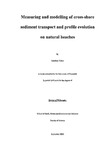Measuring and modelling of cross-shore sediment transport and profile evolution on natural beaches
| dc.contributor.author | Tinker, Jonathan | |
| dc.contributor.other | Faculty of Science and Engineering | en_US |
| dc.date.accessioned | 2011-05-13T13:15:08Z | |
| dc.date.available | 2011-05-13T13:15:08Z | |
| dc.date.issued | 2008 | |
| dc.identifier | Not available | en_US |
| dc.identifier.uri | http://hdl.handle.net/10026.1/470 | |
| dc.description.abstract |
Cross-shore sediment transport is the dominant process causing beach profile evolution. The ability to model cross-shore sediment transport allows prediction of the future beach state be made. Due to a balance between opposing mechanisms, cross-shore sediment transport is difficult to predict. One route to make these predictions is with the development of measurement based parameterisation. This study builds on previousp arameterisationtsh at have relatedc ross-shorev elocity moment (predictorso f suspendeds edimentt ransporta ccordingt o the energeticsa pproacht o sediment transport)t o normalisedd epth( a proxy of cross-shorep osition),t o presenta new shapef unction parameterisationT. he presentp arameterisatiohna s beend evelopedf rom field measurementosf depth-integratedcr oss-shores uspendeds edimentt ransportm easuredd uring a month long field campaigna t SennenC ove, Cornwall, UK. This parameterisationis an improvemento f the previouss hapef unction parameterisationin three key areas;i ) removest he dependencyo n the energetics approach, and so includes all transport mechanisms, ii) incident energy (parameteriseda s breakpointd epth- hb) is considereda, nd so allows this shapef unction to be usedu nder a wide rangeo f energyc onditions,i ii) the swashz one processesa re consideredin detail. The new shapef unction parameterisationis the sum of four components hapef unctions that represenmt eana nd oscillatoryt ransporti n the surf- and shoalingz onea nd on- and offshore transporti n the swash-zoneA. s eachc omponents hapef unction respondsin dividually to energy level, the net-transport shape function responds to varying conditions. Under high-energy conditions the shape function predicts onshore transport in the shoaling zone, offshore transport in the surf zone and onshore transport in the inner swash zone, while under low energy the shape function predicts all onshore transport with a peak outside the breakpoint and in the inner surf-zone. The shapef unction is implementedin a simple heuristicp rofile evolutionm odel that allows the examination of beach behaviour of under varying conditions to be examined over long (decadal) time-scalesP. reliminaryr esultss how that the shapef unction model is able to replicateo nshore and offshoreb ar migration,b ar developmenat nd bar degenerationo ver timescalen ot previously modelled.F uture work will use this model to investigatet he responseto subtletiesi n driving conditions,s ucha s the varying effect of seasonalityc omparedto randoms torms. | en_US |
| dc.description.sponsorship | the Natural Environnient Research Council | en_US |
| dc.language.iso | en | en_US |
| dc.publisher | University of Plymouth | en_US |
| dc.title | Measuring and modelling of cross-shore sediment transport and profile evolution on natural beaches | en_US |
| dc.type | Thesis | |
| dc.identifier.doi | http://dx.doi.org/10.24382/3345 |
Files in this item
This item appears in the following Collection(s)
-
01 Research Theses Main Collection
Research Theses Main


